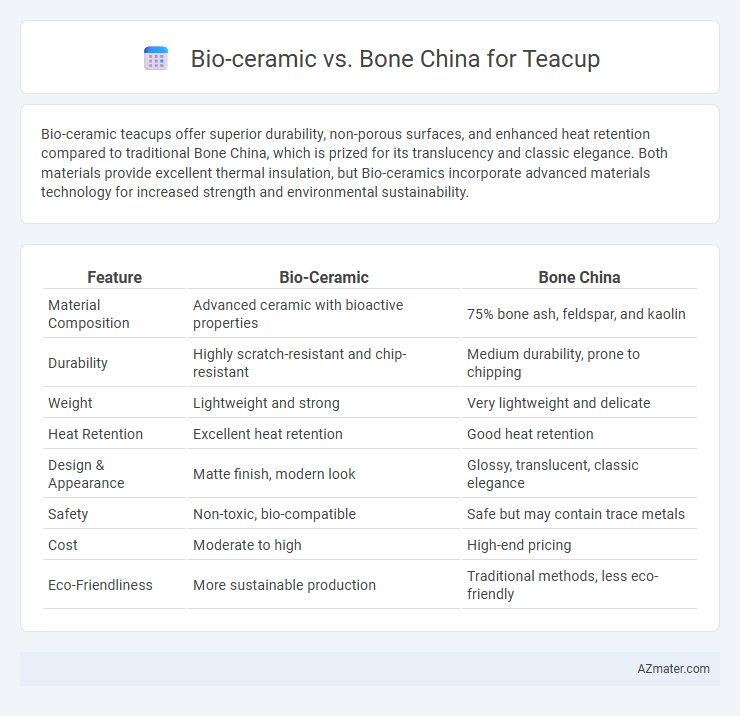Bio-ceramic teacups offer superior durability, non-porous surfaces, and enhanced heat retention compared to traditional Bone China, which is prized for its translucency and classic elegance. Both materials provide excellent thermal insulation, but Bio-ceramics incorporate advanced materials technology for increased strength and environmental sustainability.
Table of Comparison
| Feature | Bio-Ceramic | Bone China |
|---|---|---|
| Material Composition | Advanced ceramic with bioactive properties | 75% bone ash, feldspar, and kaolin |
| Durability | Highly scratch-resistant and chip-resistant | Medium durability, prone to chipping |
| Weight | Lightweight and strong | Very lightweight and delicate |
| Heat Retention | Excellent heat retention | Good heat retention |
| Design & Appearance | Matte finish, modern look | Glossy, translucent, classic elegance |
| Safety | Non-toxic, bio-compatible | Safe but may contain trace metals |
| Cost | Moderate to high | High-end pricing |
| Eco-Friendliness | More sustainable production | Traditional methods, less eco-friendly |
Introduction to Bio-ceramic and Bone China Teacups
Bio-ceramic teacups are crafted from advanced ceramic materials enhanced with bioactive compounds that offer superior durability and heat retention compared to traditional ceramics. Bone China teacups, made from a mixture of bone ash, feldspar, and kaolin, are renowned for their exceptional whiteness, translucency, and lightweight feel. Both types provide unique tactile and aesthetic qualities catering to different preferences in teacup durability and elegance.
Composition: What Makes Bio-ceramic and Bone China Unique
Bio-ceramic teacups are composed of advanced ceramic materials combining zirconia, alumina, and kaolin, providing exceptional durability and thermal resistance. Bone china contains bone ash, feldspar, and kaolin, resulting in a translucent, lightweight structure with high mechanical strength. The unique composition of bio-ceramics offers superior chip resistance, while bone china is prized for its delicate appearance and refined translucency.
Durability and Strength Comparison
Bio-ceramic teacups exhibit superior durability and strength due to their advanced composite materials, making them highly resistant to chipping and cracking under thermal stress. Bone China, while renowned for its delicate translucency and lightness, offers moderate strength but is more prone to damage from sudden impact or temperature changes. The unique molecular structure of bio-ceramics contributes to enhanced scratch resistance and long-lasting performance compared to traditional bone china in daily use.
Heat Retention and Thermal Properties
Bio-ceramic teacups exhibit superior heat retention due to their dense, non-porous structure, which minimises thermal conductivity and keeps beverages warmer for longer periods. Bone china, while renowned for its delicate and lightweight design, has moderate thermal insulation but tends to lose heat faster compared to bio-ceramic materials. The enhanced thermal stability of bio-ceramics makes them ideal for prolonged tea-drinking sessions, whereas bone china offers elegance but with quicker cooling times.
Safety and Health Considerations
Bio-ceramic teacups are known for their non-toxic, lead-free composition, making them a safer choice for daily use compared to traditional Bone China, which occasionally contains trace amounts of lead and cadmium that could leach into beverages. Bio-ceramics exhibit high resistance to thermal shock and do not react with acidic or alkaline substances, ensuring no harmful chemicals migrate into tea, thereby promoting better health safety. Bone China, while celebrated for its translucency and strength, may pose minor health risks if not properly glazed or if used with highly acidic drinks over time.
Aesthetic Appeal and Design Options
Bio-ceramic teacups offer a sleek, modern aesthetic with a smooth, often matte finish that enhances minimalist and contemporary designs. Bone china teacups are renowned for their delicate translucency, classic elegance, and intricate patterns, making them ideal for traditional and ornate settings. Both materials provide diverse design options, but bone china's ability to showcase fine detailing often appeals more to collectors seeking timeless sophistication.
Environmental Impact and Sustainability
Bio-ceramic teacups, made from natural mineral compounds, offer enhanced durability and lower environmental footprints due to energy-efficient low-temperature firing and reduced raw material extraction. Bone china production involves animal bone ash, raising ethical and sustainability concerns, while its high firing temperatures contribute to greater energy consumption. Choosing bio-ceramic teacups supports eco-friendly manufacturing practices and aligns with sustainable consumer preferences.
Price Differences and Value for Money
Bio-ceramic teacups generally cost more than bone china due to advanced manufacturing techniques and superior durability, often priced between $30 to $60 per cup compared to bone china's $15 to $40 range. Bio-ceramic offers enhanced heat retention and resistance to chipping, providing better long-term value despite the higher initial investment. Bone china remains popular for its lightweight elegance and affordability, making it a cost-effective choice without sacrificing traditional aesthetic appeal.
User Experience: Taste, Feel, and Usability
Bio-ceramic teacups offer a smooth, non-porous surface that preserves the pure taste of tea without imparting any metallic or chalky aftertaste, enhancing the drinking experience for tea connoisseurs. Bone China provides a delicate, lightweight feel with superior heat retention, maintaining the warmth of tea longer while offering a luxurious tactile sensation. Both materials excel in usability with robust chip resistance and ergonomic designs, but Bio-ceramics often feature greater thermal shock resistance, making them ideal for daily use and repeated dishwasher cycles.
Final Verdict: Which Teacup Material Suits You Best?
Bio-ceramic teacups offer superior durability and heat retention due to their innovative mineral composition, making them ideal for everyday use and outdoor settings. Bone china teacups, prized for their elegant translucency and refined craftsmanship, provide a luxurious drinking experience perfect for formal occasions or collectors. Select bio-ceramic for practicality and resilience, or choose bone china for aesthetic appeal and tradition in upscale tea drinking.

Infographic: Bio-ceramic vs Bone China for Teacup
 azmater.com
azmater.com